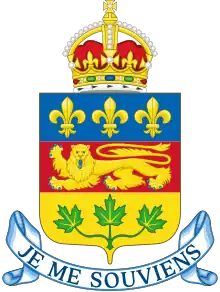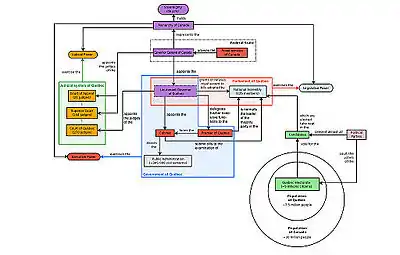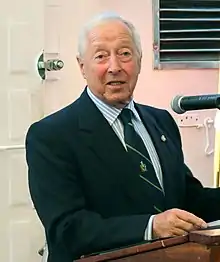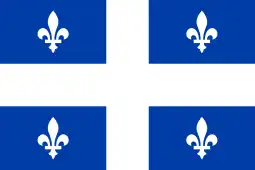Government of Quebec
The Government of Quebec (French: Gouvernement du Québec) is the body responsible for the administration of the Canadian province of Quebec. A constitutional monarchy, the Crown is the corporation sole, assuming distinct roles: the executive, as the Crown-in-Council; the legislature, as the Crown-in-Parliament; and the courts, as the Crown-on-the-Bench. The powers of the Crown are exercised on behalf of three institutions—the Executive Council (Cabinet); the National Assembly; and the judiciary, respectively.
| Constitutional monarchy | |
 Coat of arms of Quebec Logo of Government of Quebec | |
| Formation | 1 July 1867 |
|---|---|
| Founding document | Constitution Act, 1867 |
| Country | Canada |
| Website | www |
| Crown | |
| Sovereign | Monarch |
| Vice-regal representative | Lieutenant Governor |
| Legislative (Crown-in-Parliament) | |
| Legislature | Provincial Parliament (National Assembly) |
| Meeting place | Hôtel du Parlement, Quebec City |
| Executive (Crown-in-Council) | |
| Head of government | Premier |
| Main organ | Executive Council of Quebec |
| Judicial (Crown-on-the-Bench) | |
| Court | Quebec Court of Appeal (highest provincial court) |
The term Government of Quebec (French: Gouvernement du Québec) is typically used to refer to the executive—ministers of the Crown (the Executive Council) of the day, and the non-political staff within each provincial department or agency, i.e. the civil services, whom the ministers direct—which corporately brands itself as the Gouvernement du Québec, or more formally, His Majesty's Government (French: Gouvernement de Sa Majesté).[1][2]
In both senses, the current construct was established when the province joined Confederation in 1867. Quebec is a secondary jurisdiction of Canada, a constitutional monarchy with a parliamentary democracy in the Westminster tradition; a Premier—presently François Legault of the Coalition Avenir Québec—is the head of government and is invited by the Crown to form a government after securing the confidence of the National Assembly, typically determined through the election of enough members of the National Assembly (MNAs) of a single political party in a election to provide a majority of seats, forming a governing party or coalition.[3] The sovereign is King Charles III, Canada's head of state, who is represented provincially in Quebec by the lieutenant governor, presently J. Michel Doyon.
The Crown
King Charles III, as monarch of Canada is also the King in Right of Quebec. As a Commonwealth realm, the Canadian monarch is shared with 14 other independent countries within the Commonwealth of Nations.[9] Within Canada, the monarch exercises power individually on behalf of the federal government, and the 10 provinces.
Lieutenant governor
While the powers of the Crown are vested in the monarch, they are exercised by the lieutenant governor, his personal representative, typically on the binding advice of the premier and Executive Council.
Constitutional role
In Canada, lieutenant governor is appointed by the governor general, on the advice of the prime minister of Canada.[13] Thus, it is typically the lieutenant governor whom the premier and ministers advise, in exercising much of the royal prerogative.
While the advice of the premier and Executive Council is typically binding on the lieutenant governor, there are occasions when the lieutenant governor has refused advice. This usually occurs if the premier does not clearly command the confidence of the elected National Assembly.
Ceremonial role
The lieutenant governor is tasked with a number of governmental duties. Not among them, though, is delivering the Throne Speech, which sets the lieutenant governor of Quebec apart from the other Canadian viceroys. (Instead, new sessions begin with the Opening Speech by the premier.[14][15]) The lieutenant governor is also expected to undertake various ceremonial roles. For instance, upon installation, the lieutenant governor automatically becomes a Knight or Dame of Justice and the Vice-Prior in Quebec of the Most Venerable Order of the Hospital of Saint John of Jerusalem. The lieutenant governor presents numerous other provincial honours and decorations[16] and various awards that are named for and presented by the lieutenant governor,[17] which were reinstated in 2000 by Lieutenant Governor Lise Thibault. These honours are presented at official ceremonies, which count among hundreds of other engagements the lieutenant governor takes part in each year, either as host or guest of honour; in 2006, the lieutenant governor of Quebec undertook 400 engagements and 200 in 2007.[18]
Executive power
.jpg.webp)
The executive power is vested in the Crown and exercised "in-Council", meaning on the advice of the Executive Council; conventionally, this is the Cabinet, which is chaired by the premier and comprises ministers of the Crown. The term Government of Quebec, or more formally, His Majesty's Government refers to the activities of the King-in-Council. The day-to-day operation and activities of the Government of Quebec are performed by the provincial departments and agencies, staffed by the non-partisan public service and directed by the elected government.
Premier and Cabinet
The premier of Quebec (French: premier ministre du Québec, lit. 'prime minister of Quebec') is the primary minister of the Crown. The premier acts as the head of government for the province, chairs and selects the membership of the Cabinet, and advises the Crown on the exercise of executive power and much of the royal prerogative. As premiers hold office by virtue of their ability to command the confidence of the elected Nation Assembly, they typically sit as a MNA and lead the largest party or a coalition in the Assembly. Premiers hold office until resignation or removal by the lieutenant governor after either a motion of no confidence or defeat in a general election.[19] Among Canadian premiers, the Quebec premier is unique, in that new sessions begin with the Opening Speech by the premier,[14] rather than a speech from the throne by the lieutenant governor, as is the case federally as well.
In Canada, the Cabinet (French: Conseil des ministres, lit. 'council of ministers') of provincial and territorial governments are known as an Executive Council (French: Conseil exécutif).
François Legault has served as Premier since October 18, 2018, after the Coalition Avenir Québec won a majority government following the 2018 election.
Legislative power
.jpg.webp)
The Parliament of Quebec consists of the unicameral 125-member National Assembly of Quebec (French: Assemblée Nationale), and the Crown-in-Parliament. As government power is vested in the Crown, the role of the lieutenant governor is to grant royal assent on behalf of the monarch to legislation passed by the National Assembly. The Crown does not participate in the legislative process save for signifying approval to a bill passed by the Assembly.
Until 1968, the Quebec legislature was bicameral,[20] consisting of the Legislative Council and the Legislative Assembly. In that year, the Legislative Council was abolished and the Legislative Assembly was renamed the National Assembly. Quebec was the last province to abolish its legislative council.
Government
The legislature plays a role in the election of governments, as the premier and Cabinet hold office by virtue of commanding the body's confidence. Per the tenants of responsible government, Cabinet ministers are almost always elected MNAs, and account to the National Assembly.
Opposition
The second largest party of parliamentary caucus is known as the Official Opposition, who typically appoint MNAs as critics to shadow ministers, and scrutinize the work of the government.
The Official Opposition is formally termed His Majesty's Loyal Opposition, to signify that, though they may be opposed to the premier and Cabinet of the day's policies, they remain loyal to Canada, which is personified and represented by the King.[21]
Judiciary
The principal judicial courts of Québec are the Court of Quebec, the Superior Court and the Court of Appeal. The appointment judges of the Court of Quebec is a function of the provincial Crown on advice of the premier and Executive Council, while the federal Cabinet determines the composition of the other two.
Graphical representation

References
- MacLeod, Kevin S. (2008), A Crown of Maples (PDF) (1 ed.), Ottawa: Queen's Printer for Canada, p. 18, ISBN 978-0-662-46012-1, retrieved June 21, 2009
- Government of Canada, Department of Justice (1999-11-03). "Department of Justice - Final Report of the French Constitutional Drafting Committee". www.justice.gc.ca. Retrieved 2021-03-29.
- "Westminster Tradition". www.leg.bc.ca. Retrieved 2021-03-29.
- Claude Bouchard (16 February 2016). "Jugement No. 200-17-018455-139" (PDF) (in French). Cour supérieure du Québec. p. 16. Retrieved 17 February 2016 – via Le Devoir.
- Romaniuk, Scott Nicholas; Wasylciw, Joshua K. (February 2015). "Canada's Evolving Crown: From a British Crown to a "Crown of Maples"". American, British and Canadian Studies Journal. 23 (1): 108–125. doi:10.1515/abcsj-2014-0030.
- Department of Canadian Heritage (2015). "Crown of Maples: Constitutional Monarchy in Canada" (PDF). Her Majesty the Queen in Right of Canada. p. 3. Archived from the original (PDF) on 10 November 2012. Retrieved 16 February 2016.
- "Queen and Canada". The Royal Household. Retrieved 16 February 2016.
- "The Queen of Canada". Government of Canada. Archived from the original on 24 February 2016. Retrieved 16 February 2016.
- [4][5][6][7][8]
- Hicks, Bruce (2012). "The Westminster Approach to Prorogation, Dissolution and Fixed Date Elections" (PDF). Canadian Parliamentary Review. 35 (2): 20.
- MacLeod 2008, p. 36
- Government of Canada (4 December 2015). "Why does the Governor General give the Speech?". Queen's Printer for Canada. Archived from the original on 26 April 2018. Retrieved 17 December 2015.
- [10][11][12]
- National Assembly of Quebec. "Parliament and Government". Éditeur officiel du Québec. Archived from the original on February 23, 2010.
- Wiseman, Nelson (2009). "In Search of a Quebec Constitution" (PDF). Revue québécoise de droit constitutionnel. Quebec City: l'Association québécoise de droit constitutionnel. 2: 144. Retrieved 4 March 2011.
- "Canada Wide > About Us > The Order of St. John > The Order of St. John in Canada". St. John Ambulance Canada. Archived from the original on 4 October 2009. Retrieved 2 June 2009.
- Office of the Lieutenant Governor of Quebec. "Awards Program > Lieutenant Governor of Québec Awards Program". Éditeur officiel du Québec. Archived from the original on 29 April 2010. Retrieved 6 July 2009.
- Berezovsky, Eugene (2009). Staff of Canadian Monarchist News (ed.). $1.52 per Canadian: The Cost of Canada's Constitutional Monarchy (PDF) (4 ed.). Toronto: Monarchist League of Canada. p. 3. Archived from the original (PDF) on 7 July 2009. Retrieved 15 May 2009.
- Brooks 2007, p. 235
- "Parliament A to Z". Bicameral System. National Assembly of Quebec. Archived from the original on May 30, 2011. Retrieved June 29, 2011.
- Schmitz, Gerald (December 1988), The Opposition in a Parliamentary System, Ottawa: Queen's Printer for Canada, archived from the original on 25 April 2009, retrieved 21 May 2009
Works cited
- Brooks, Stephen (2007). Canadian Democracy: An Introduction (5 ed.). Don Mills: Oxford University Press. ISBN 978-0-19-543103-2.
.jpg.webp)

